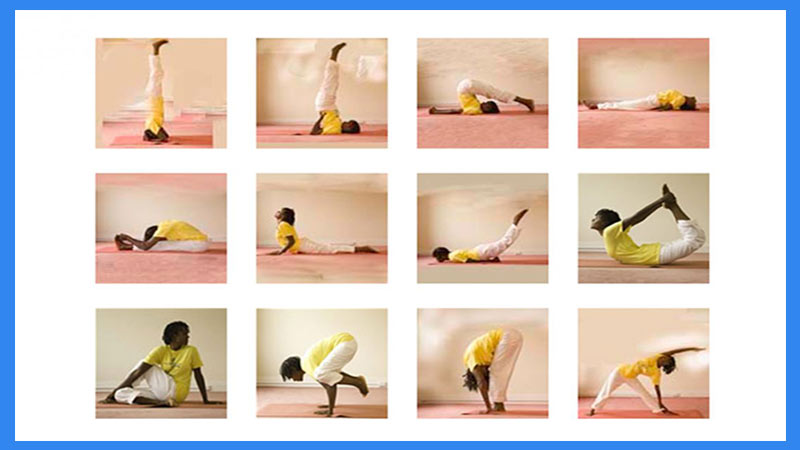Table of Contents
Swami Sivananda’s Yoga Sequence Of 12 Yogasanas
Swami Sivananda Saraswati (1887 – 1963) was a Great Master and a Great Yogi. As a major spiritual voice of his time, Sri Swami Sivananda Saraswati guided thousands of spiritual seekers, disciples, and aspirants all over the world. His life was dedicated to service to humanity. He developed a sequence of 12 basic Yoga asanas. These 12 basic poses or asanas are much more than just stretching. They open the energy channels, chakras and psychic centers of the body while increasing flexibility of the spine, strengthening bones and stimulating the circulatory and immune systems. Along with proper breathing or pranayama, asanas also calm the mind and reduce stress.
The sequence of 12 basic Yoga asanas is structured in such a way that it stimulates and balances the chakras, starting from the Sahasrara Chakra, then Vishuddhi Chakra, Anahata Chakra, Manipura Chakra and then Swadhisthan and Mooladhara Chakra.
Sahasrara chakra (Crown Chakra)
1. Sirsasana (Headstand)
Swami Sivananda called Sirsasana “A blessing and a Nectar” and it would be the first asana of his series. This asana stimulates the Sahasrara Chakra or Crown Chakra. Sahasrara chakra is the center of spirituality or enlightenment. By the practice of Sirsasana, the brain can draw plenty of Prana and blood. This acts against the force of gravity and draws an abundance of blood from the heart. This leads to natural Pranayama and Samadhi by itself. A great benefit is derived by sitting for meditation after Sirshasana.
Vishuddhi chakra (Throat Chakra)
2. Sarvangasana (Shoulder Stand)
3. Halasana (Plough Pose)
In the sequence of Swami Sivananda, Sarvangasana and Halasana are the next two asanas, which stimulate Vishuddha Chakra, the center of purification. The divine nectar, which is produced at Bindu Chakra, is tasted, processed and purified at Vishuddhi Chakra for further use throughout the body. This chakra is the center of communication and sound. It is also the location of expression of creativity through thought, speech, and writing.
Anahata Chakra (Heart Chakra)
4. Matsyasana (Fish Pose)
The next asana of Sivananda Yoga Sequence to stimulate the Anahata Chakra is Matsyasana. Anahata Chakra is the center associated with the sense of touch, emotions, ego, passions, impulses, anger and strength. It is situated in the spine, behind the sternum and at the level of the heart. Matsyasana opens the chest and heart completely, thus stimulating the Heart Chakra. As Anahata Chakra gets purified, the feelings of universal fellowship and tolerance begin to develop and all beings are accepted and loved for what they are.
Manipura Chakra (Solar Plexus Chakra)
5. Paschimothanasana (Forward Bend Pose)
6. Bhujangasana (Cobra Pose)
7. Shalabhasana (Locust Pose)
8. Dhanurasana (Bow Pose)
9. Ardh Matseyendrasana ( Seated Half Spinal Twist Pose)
Manipura Chakra or the Solar Plexus Chakra is situated in the spine behind the navel. Paschimottanasana, Bhujangasana, Salabhasana, Dhanurasana, and Ardha Matsyendrasana stimulate this Chakra by compressing it (Forward Bend), pressing it into the floor (Cobra, Locust, and Bow) or by squeezing it (Half Spinal Twist). Manipura Chakra is the center of self-assertion, dynamism, and dominance. It is the seat of the element fire within the body. It is the center concerned with the vital processes of digestion and food metabolism. It also governs the function of gastric glands, the pancreas, gall bladder, adrenal glands and so on. Stimulating the Manipura Chakra will help people suffering from sluggishness, indigestion, diabetes and even depression.
The above stated nine asanas had a clear impact on the energy centers (Chakras) as stated above. At the same time, these asanas had other benefits as well that will help the practitioner to develop great overall health (physical, mental, emotional and spiritual health) helping him in achieving his goal. Remaining three asanas that Swamiji advocated in his series of 12 asanas are –
10. Kakasana (Crow Pose)
The Crow Pose is one of the most beneficial of balancing poses. Besides increasing physical and mental balance, the Crow develops mental tranquility and also strengthens the arms, wrists, and shoulders of the practitioner. The muscles of fingers, wrists, and forearms are stretched and strengthened. Kakasana helps to improve concentration and remove lethargy.
11. Uttanasana (Standing Forward Bend Pose)
The stretch that is experienced in the final pose of Uttanasana is too intense and hence the name of the pose – ‘Intense Forward Bend’. Further, in the final pose, the head is at a lower level than the heart, which enables the supply of fresh blood to the head, benefitting the brain and other important organs in the region. This makes Uttanasana a great pose to remove anxiety and depression. The Swadhisthan Chakra and Mooladhara Chakra is stimulated by its regular practice.
12. Trikonasana (Triangle Pose)
Trikonasana is for the health & wellness of the practitioner. It brings stability, strength, and stamina in one’s life. Trikonasana, also called Triangle Pose, is known to stretch and strengthen the muscles of the back, thighs, back of the legs and waist. It is one of the best ways to lose weight, reduce waistline, provide the best of abdominal exercises, lower back stretches and very good for knee joint. It also helps with balance. This asana too has an impact on the Swadhisthan Chakra and Mooladhara Chakra. It augments the movement of the Half Spinal Twist and is the last of the twelve basic asanas in the Sivananda cycle of 12 Yoga Poses. With the completion of this pose, we have now stretched the spine in every direction: front-to-back, side-to-side, and twisting to both sides.
The 12 basic poses were carefully selected and include inversions, backbends, forward bends, twists, balances, and hamstring stretches. A little of everything, in other words. The poses are done slowly and with control and awareness to stretch and strengthen the body as well as open the chakras.

